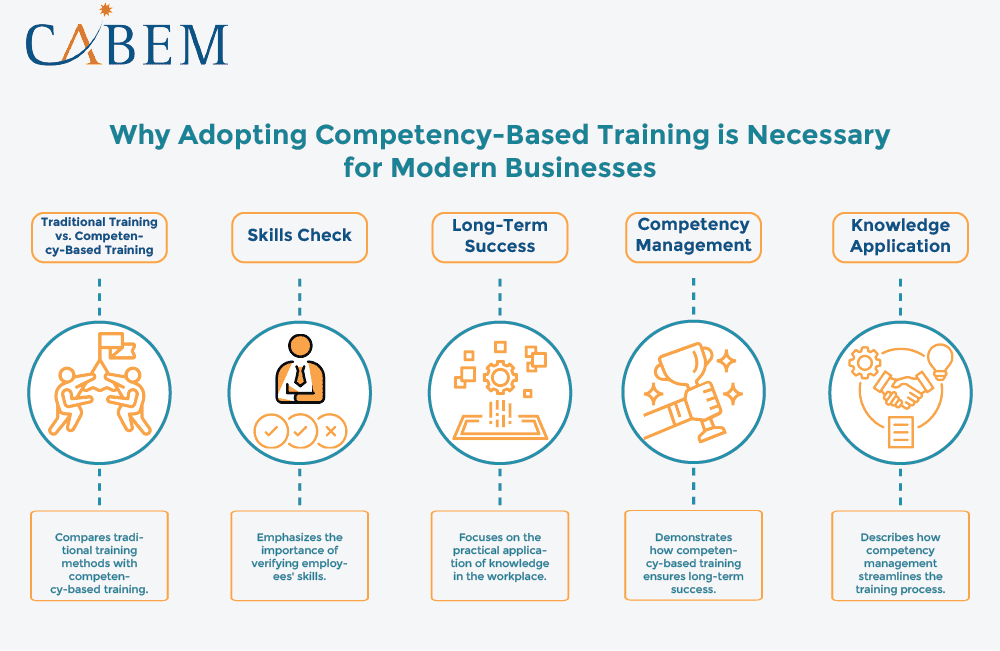Competency-based training fills gaps that traditional methods leave. It checks to ensure employees have the necessary skills. It’s about applying knowledge, not only memorizing it. This approach sets your team up for long-term success.
Traditional training programs can be thorough. But let’s be honest—new hires often forget things. They’re already overloaded with information. Plus, good training isn’t limited to facts. It’s about making sure employees can actually do their jobs as needed.
This blog explores why competency-based training is necessary. It also discusses how businesses can make this process easy with competency management.
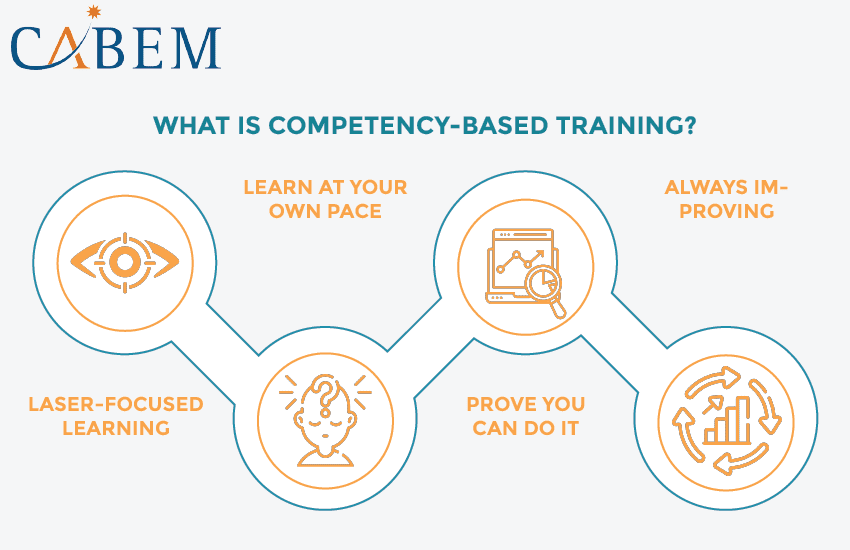
What is Competency-Based Training?
Traditional is all about lectures and memorization. It often leaves one wondering whether their employees actually do the job. Competency-based training (CBT) takes a results-oriented approach. It ensures your workforce has the practical skills needed for success.
Here’s how CBT gets real results:
- Laser-Focused Learning:
No more info overload. CBT breaks down complex skills into bite-sized modules. Each of these modules targets a specific competency for the job. Employees gain exactly what they need to excel. - Learn at Your Own Pace:
CBT lets learners progress by mastering each module. They learn as per competency rather than sitting through hours of training. It caters to individual learning styles and ensures knowledge sticks. - Prove You Can Do It:
CBT assessments ditch theory and mimic real-world tasks. They check if employees can actually apply their knowledge, not just recite facts. - Always Improving:
CBT identifies skill gaps through assessments. Targeted training then fills those gaps. This keeps your workforce adaptable and ahead of the curve.
In short, CBT is a strategic upgrade for your training program. It builds practical skills, measures application, and creates a workforce ready for success.
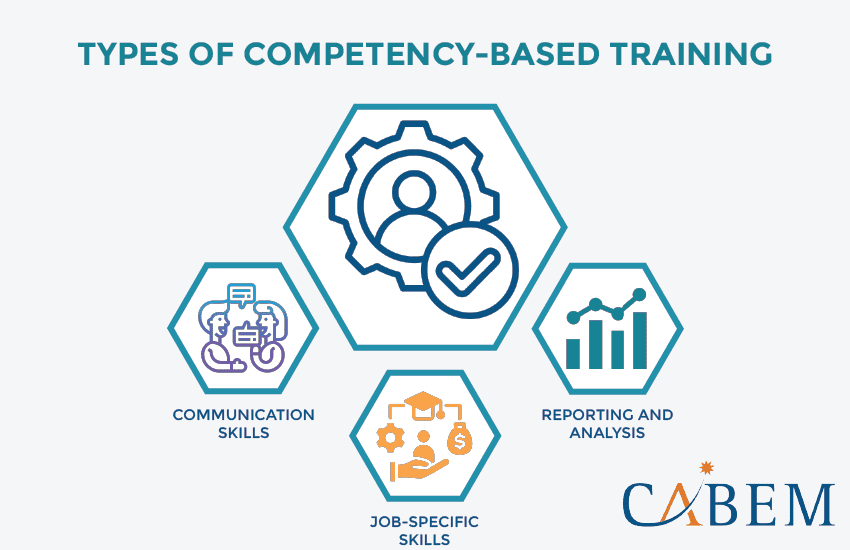
Types of Competency-Based Training
Competency-based training (CBT) isn’t a one-size-fits-all solution. It can be tailored to address a variety of specific skills needed in the workplace. Here are some examples:
Communication Skills
Effective workplace communication training is crucial across industries. Competency-based learning can target different areas like:
- Sales Pitches:
Crafting powerful pitches that resonate with potential customers. This includes teaching employees to read the room, answer questions, and handle objections. - Customer Service Interactions:
Providing scripts and guides for handling common customer issues. This ensures consistent and professional interactions.
Job-Specific Skills
CBT encourages professional development. It excels at ensuring employees can perform core job tasks. This includes:
- Following Procedures:
Factories can train their workers by comparing established protocols. - Project Management:
Upskilling managers may require taking a project from start to finish. This helps identify areas for improvement in their independent project management skills.
Reporting and Analysis
CBT can address challenges in these areas by:
- Report Writing:
Establishing clear expectations for different reports. It may also provide examples of what high-quality reports look like. - Data Analysis:
Developing analytical skills can help employees understand data. They can then use this knowledge to translate the data into actionable insights.
Beyond these examples, training focuses on a wide range of workplace competencies, including:
- Conflict Resolution:
Equipping employees with the skills to navigate disagreements and find win-win solutions. - Analytical Thinking:
Developing the ability to analyze complex situations and identify key problems. This helps make data-driven decisions. - Improved Customer Satisfaction:
Ensuring customer service representatives understand how to set and maintain customer satisfaction.
Customizing competency-based training programs helps organizations create a highly skilled and adaptable workforce. With CBT, they can stay ahead of the curve in today’s dynamic business environment.
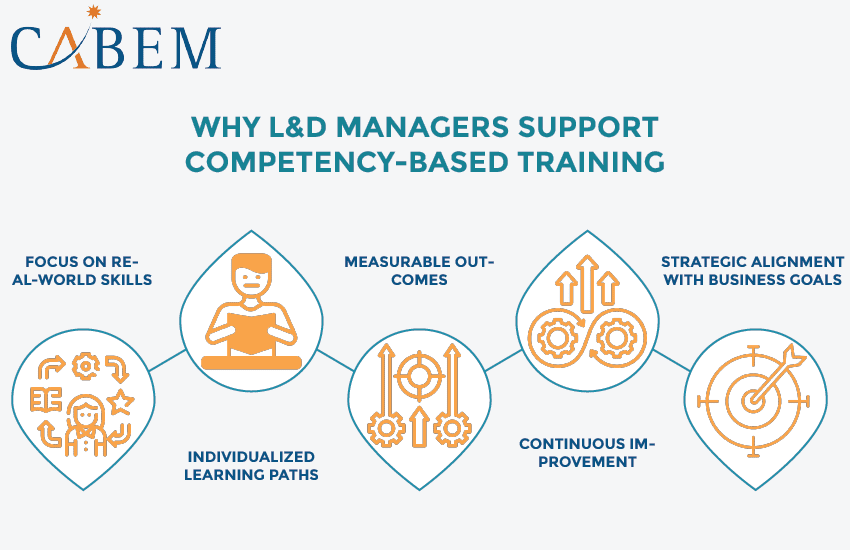
Why L&D Managers Support Competency-Based Training
Forget generic professional development training that misses the mark. Learning and development (L&D) managers are raving about CBT for four key reasons:
- Discovering Hidden Gems:
Great employees often have unconscious strengths – ingrained traits that become natural behavior. CBT helps L&D managers identify these core competencies through observation and exploration. Imagine uncovering hidden talents within your workforce – a goldmine for any organization! - Learning Beyond the Classroom:
The 70-20-10 rule highlights the limitations of traditional training. Most development (70%) happens on the job! Competency-based training understands this. It focuses on activities like coaching, mentoring, project work, and training.
For example, improving emotional intelligence might involve working with an excelling colleague. Discussing their thought processes may help you gain a deeper understanding and enhance your own. - Strategic HR Decisions:
CBT goes beyond individual development. When organizations evaluate competencies across their workforce, competency gaps become clear. Implementing a competency-based training program empowers HR to make informed decisions about recruitment, onboarding, and performance management. It’s like having a roadmap for building a high-performing workforce aligned with your business goals. - Empowering Career Growth:
CBT helps employees understand their strengths and weaknesses – their competency gaps. This self-awareness allows them to target their development efforts effectively. A competency-based training program equips employees with a clear roadmap for growth. When employees take charge of their growth, it’s a win-win for both them and the organization!
CBT isn’t just another training trend; it’s a strategic approach. These development programs benefit both employees and organizations.
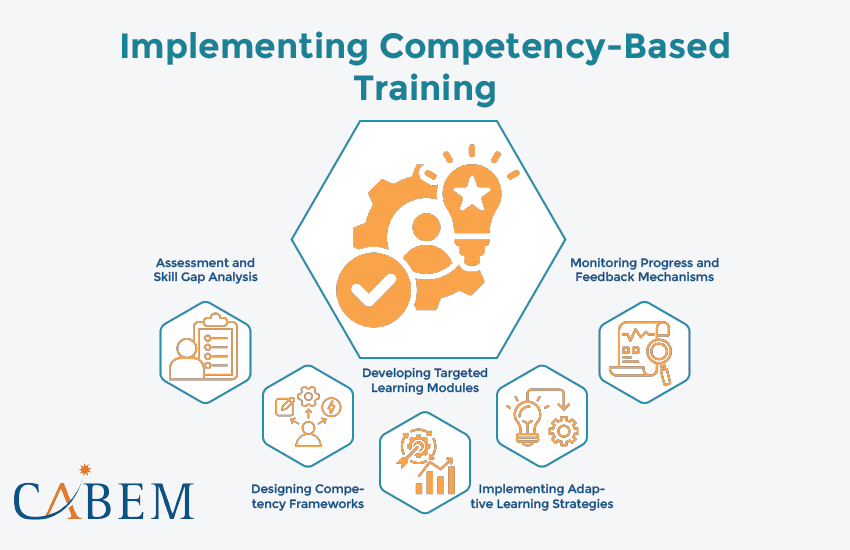
Implementing Competency-Based Training
Now, let’s have a look at the 12-step CBT framework:
Step #1: Is Training the Answer?
Assess if the performance issue stems from a lack of knowledge, skill, or attitude. If it requires managerial action, like revised job descriptions or performance reviews, CBT may not be the solution.
Step #2: Defining Measurable Needs
Who needs competency-based training? What are their goals? What’s their work environment like? These are just some questions to identify specific training needs. They ensure the program is on the right track.
Step #3: Real-World Application
An efficient competency-based training program thrives on practicality. Ensure your training provides opportunities to apply new skills in real-life scenarios. The more applications, the better the learning retention.
Step #4: Understanding Your Trainees
Not all training requires in-depth knowledge of your employees’ backgrounds. But, a probing survey can reveal their current skill levels and areas for improvement.
Step #5: Identifying Top Performers
Look for your organization’s superstars. What competencies do they share? Are these competencies relevant to the roles you’re training for? Remember, focus on objectively measured performance indicators.
Step #6: The Difference Makers
Compare top performers to average performers. What sets them apart? What skills do they excel in? How do they approach work? Identifying these differences pinpoints the competencies needed for success.
Step #7: Measuring Up
How will you assess competency? Will you be implementing CABEM’s Competency Manager? Behavioral rubrics, skill tests, or even measuring work output are all on the table.
Step #8: Defining Competency Objectives
Clearly outline the desired outcomes of the training. What competencies will trainees demonstrate upon completion? Frame objectives in clear, measurable terms. For example, a salesperson might learn to identify viable leads within two minutes of a call.
Step #9: Gauging Success
How will you know if the training worked? How well can trainees apply their new skills to their jobs? Determine the metrics that will measure this.
Step #10: Crafting Content
Developing training content is a process in itself. Consider outsourcing this to instructional content design experts.
Step #11: Delivery Methods
How will you deliver the training? Will traditional classrooms work best? Or is on-the-job training, mentoring, e-learning, or job shadowing more effective?
Step #12: Measuring On-the-Job Performance
Remember the “rule of three” from step 3. Employees should have opportunities to apply their new skills in multiple real-life situations. This process helps solidify learning.
By embracing the CBT philosophy, businesses can unlock employee potential. It helps them build a highly skilled workforce ready to tackle any challenge.
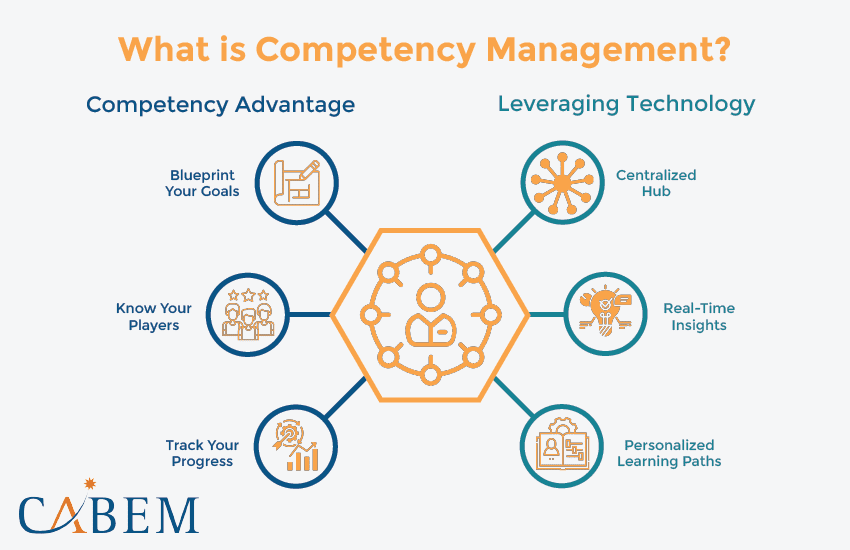
What is Competency Management?
Competency management is a strategic approach that aligns your workforce with your goals. Here’s how it wins:
- Right People, Right Skills:
Competency management identifies the critical skills needed for each role. It’s like having a blueprint for your ideal workforce. By assessing employees against these competencies, you can ensure they have what it takes to do the job. - Investing in Your Best:
This approach helps you identify high-potential employees. Imagine spotting hidden gems within your workforce! Competency management empowers you to invest in their development and plan for future leadership roles. - Fair Performance Reviews:
Out with the guesswork! Competency management provides a clear framework for evaluating and measuring performance. Think of it like a shared scoreboard – everyone knows the goals and how they’re measured. - Engaged & Satisfied Employees:
Clarity is key! Employees feel valued when they understand the skills needed for their roles and have opportunities to develop. This translates to higher job satisfaction, increased productivity, and lower turnover.
Building Your Competency Advantage
Creating a winning system requires planning. Here’s the roadmap:
- Blueprint Your Goals: Identify the core competencies for success in each role. Align these with your organization’s goals – it’s all about building a team that propels you forward.
- Know Your Players: Assess current employee competencies. This can be done through self-assessments, manager feedback, or 360-degree reviews.
- Bridging the Gaps: Compare current skills to desired competencies. Identify the gaps and prioritize areas for development. This is where targeted training and development come in handy.
- Level Up Your Workforce: Design training programs to address skill gaps. Think workshops, online courses, mentoring, coaching, or job rotations – get creative!
- Track Your Progress: Monitor and evaluate employee development. Provide feedback and support throughout the process.
- Competencies Everywhere: Integrate competencies into your HR processes. Competency management helps you navigate everything from recruitment to succession planning.
By embracing competency management, you can build a high-performing workforce. It equips your team with the skills and knowledge to achieve your organization’s goals.
Leveraging Technology to Enhance Competency Management
Competency management has evolved beyond traditional methods. Innovative software platforms are playing a critical role in streamlining the process. Here’s how technology empowers competency management:
- Centralized Hub: Gone are the days of scattered spreadsheets. Competency management software creates a single system for managing everything. You can track employees’ skills, assessments, development plans, and progress. It’s like having a mission control for your workforce development.
- Real-Time Insights: Employee training isn’t a guessing game. The CBT software provides real-time data on your workforce’s overall competency levels. Identify trends, measure training impact, and make data-driven decisions about talent management. Think of it like having a real-time map of your workforce’s strengths and weaknesses.
- Personalized Learning Paths: Technology unlocks customization. The software can create personalized employee training paths based on skills and career goals. Access online platforms, e-learning modules, and virtual training sessions – all under one roof.
By embracing competency management software, organizations can transform their talent development initiatives. This technology empowers data-driven decision-making and streamlines processes. And the best part? It cultivates a highly skilled and adaptable workforce ready to tackle any challenge.
Conclusion
Traditional training often falls short. Competency-based training bridges the gap by ensuring your workforce possesses the required skills. It’s a strategic upgrade that measures application, not just memorization.
Implementing CBT requires a systematic approach. CABEM’s Competency Management Software simplifies this process by providing a centralized hub for managing everything. From skills and assessments to development plans and progress tracking, you can find it all in one place.
Empower your employees and unlock their potential. Visit CABEM’s website to learn more about our industry-leading Competency Management Software.
Ready to see how CBT can transform your talent development initiatives? Don’t let your workforce become stagnant – invest in their future; invest in CBT with CABEM!
Frequently Asked Questions (FAQs)
Can any industry use competency-based training?
Yes! CBT benefits industries where specific competencies are critical. CBT applies to any sector, from healthcare professionals to manufacturing workers. It bridges the gap between theory and practice. Imagine doctors mastering procedures or factory workers honing technical expertise. CBT makes it possible across various fields.
How to implement competency-based training software?
To implement CBT software, identify skill needs. Then, choose a software like CABEM’s Competency Management that fits your requirements. Import data and competencies, develop training content, and decide on delivery (online or in-person). Launch the software after training users and track progress for real-world impact.
Is it effective to use competency-based training?
Yes, research strongly supports CBT’s effectiveness. Competency-based training lets you:
- Focus on outcomes
- Provide individualized learning
- Make data-driven decisions
Can I implement competency-based training myself?
You can develop a basic CBT program in-house. However, competency management software like CABEM’s offers significant advantages for comprehensive training. Consider the time saved through automation and the valuable data analytics software provides. While you can go solo, CABEM allows you to maximize the impact of your CBT initiatives.

